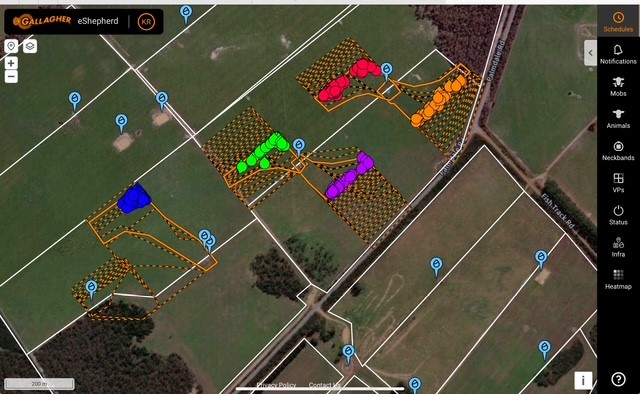Revolutionising Grazing by Reducing Labour Demands During the Busy Summer Season
Sunday, 17 November, 2024

For Kent Rochester of KM Farms in Western Australia, managing grazing was always an intensive process. Since 2018, Kent has been using poly braided wire and posts to divide his farm into small sections, rotating his cattle in groups of 200 to 500 yearlings every one to two days. But with eShepherd, Kent has been able to take grazing to a whole new level. "Now, I can divide areas as small as 0.1 hectares and move groups of around 50 head several times a day," he says. "There’s no way I could keep up with that using the old methods without drastically increasing labour."
For Kent, who farms from a wheelchair, eShepherd has been a game changer. In the past, he had to hire labour to set up and move temporary fences. Every cattle shift had a cost. Now, he’s able to manage his entire grazing plan from his iPad, eliminating the need for temporary fences and drastically reducing labour costs. "The best part is, I get to do it all myself," Kent explains. "I can’t open a gate, but I can control hundreds of cattle through complex rotations from wherever I am."
Before eShepherd, a typical summer day for Kent involved hours of setting up temporary fences, moving cattle, and checking pastures. "It could take anywhere from an hour to half a day," he recalls. Now, Kent spends just a few minutes every two or three days, using eShepherd’s virtual fencing to set up new grazing sections. "I can draw virtual paddocks and schedule when each section opens up, all while sitting down with a beer," he jokes. "It’s given me time to focus on other areas of the business that needed attention."
The unexpected benefits have been eye-opening for Kent. Not only have his labour needs decreased, but his cattle are also thriving in this new system. "The animals learnt the virtual fences quickly, and they’re actually gaining more weight per head while we use less grass," he shares. "Even in what’s shaping up to be our lowest rainfall year, we’re producing more beef per hectare."
One specific challenge eShepherd helped Kent tackle was grazing areas within his silage crop that couldn’t be mowed or harvested. "I can now graze parts of laneways and areas around sheds that were otherwise impractical," he says. And thanks to eShepherd’s remote control capabilities, he even managed the farm’s grazing while on holiday 1,000 km away.
Kent encourages other farmers to consider the potential of eShepherd. "The labour savings are immediate, but the real excitement is in how much more we’re producing. This system is helping us achieve more weight per hectare and increase our carrying capacity. It may not suit every operation, but for those it does, the impact can be profound."
For Kent, who farms from a wheelchair, eShepherd has been a game changer. In the past, he had to hire labour to set up and move temporary fences. Every cattle shift had a cost. Now, he’s able to manage his entire grazing plan from his iPad, eliminating the need for temporary fences and drastically reducing labour costs. "The best part is, I get to do it all myself," Kent explains. "I can’t open a gate, but I can control hundreds of cattle through complex rotations from wherever I am."
Before eShepherd, a typical summer day for Kent involved hours of setting up temporary fences, moving cattle, and checking pastures. "It could take anywhere from an hour to half a day," he recalls. Now, Kent spends just a few minutes every two or three days, using eShepherd’s virtual fencing to set up new grazing sections. "I can draw virtual paddocks and schedule when each section opens up, all while sitting down with a beer," he jokes. "It’s given me time to focus on other areas of the business that needed attention."
The unexpected benefits have been eye-opening for Kent. Not only have his labour needs decreased, but his cattle are also thriving in this new system. "The animals learnt the virtual fences quickly, and they’re actually gaining more weight per head while we use less grass," he shares. "Even in what’s shaping up to be our lowest rainfall year, we’re producing more beef per hectare."
One specific challenge eShepherd helped Kent tackle was grazing areas within his silage crop that couldn’t be mowed or harvested. "I can now graze parts of laneways and areas around sheds that were otherwise impractical," he says. And thanks to eShepherd’s remote control capabilities, he even managed the farm’s grazing while on holiday 1,000 km away.
Kent encourages other farmers to consider the potential of eShepherd. "The labour savings are immediate, but the real excitement is in how much more we’re producing. This system is helping us achieve more weight per hectare and increase our carrying capacity. It may not suit every operation, but for those it does, the impact can be profound."